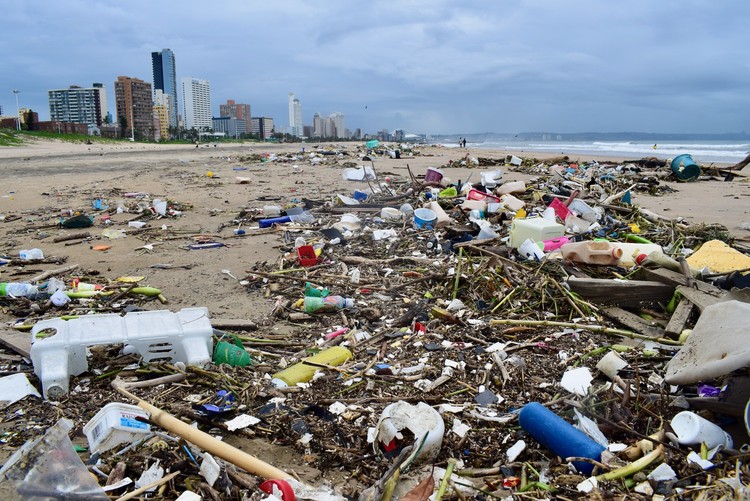How much worse are coloured plastics for the environment?
Studies are finding more reason to boycott coloured plastic products
Plastic and garbage on South Beach, Durban, in February 2023. Archive photo: Lucas Nowicki
In 2020 Clover Milk released their new blue milk bottles, in an effort to differentiate themselves from other white milk cartons on supermarket shelves. But as those on social media at the time will remember, this marketing ploy prompted a negative response from the public, including the #BoycottTheBlueBottle campaign. This was motivated largely by the fact that blue plastic is much less valuable at recycling plants and is therefore less likely to be recycled at all.
Now, four years later in 2024, studies are finding more reason to boycott coloured plastics.
A study done by the University of Cape Town and University of Leicester has shown that coloured plastics have a higher susceptibility to degradation when compared to plain plastics.
Faster rates of deterioration means more plastics breaking down into microplastics - which are harder to manage and can persist in ecosystems for decades.
Plastics consist of polymers which break down over time – a process accelerated by exposure to various elements. The colourants and dyes added to plastics can affect the stability of these polymers, influencing how quickly they degrade over time.
The study focused on the effect of UV light on rates of plastic degradation. Plastic samples were collected from a remote beach in De Hoop Nature Reserve in the Western Cape. Levels of degradation were analysed at a chemical level, and results showed that black plastics had the lowest rates of photodegradation, followed by white and silver. In contrast, coloured plastics – reds, greens and blues – deteriorated much faster.
The reason as to why seems to lie in how the colourants in the plastic react to UV light. As a pigment, black absorbs the widest range of light wavelengths – including some UV. It seems that when this absorption happens, it is converted to heat – preventing damage to the polymer and reducing breakdown of the plastic.
Silver and white plastics typically contain titanium dioxide, which can reflect UV rays, a property that protects the polymer and minimises its breakdown into microplastics.
Red, green and blue plastics absorb visible light, but not the harmful UV rays – leaving them vulnerable to sun damage, and therefore the highest rates of degradation.
The colourants in plastics are sometimes themselves harmful; titanium dioxide is neurotoxic to fish, for instance.
Silent killer
Microplastics are the silent killer of plastic waste. Due to their size, it is close to impossible to completely rid an environment of them and are easily ingested by organisms – disrupting the ecosystems and food chains that keep our biosphere in check.
An overall reduction in plastic waste – colourants included or not – would obviously be the ideal. And although alternatives to plastic are being developed, we are still ways away from implementing these at a significant enough scale to totally replace plastics. In the meantime, minimising the potential for plastics to degrade into microplastics is a step in the right direction.
The campaign against Clover Milk’s blue milk bottle began due to the plastic’s lack of versatility in the recycling process. Now, the argument behind #BoycottTheBlueBottle is further backed up by the conclusions drawn by this study. With coloured plastics showing higher rates of degradation into microplastics, posing a greater environmental risk.
In a way, Clover Milk’s blue bottle did exactly what it set out to do: it stands out on shelves – but unfortunately, so does its long-term impact on the environment.
Support independent journalism
Donate using Payfast

Don't miss out on the latest news
We respect your privacy, and promise we won't spam you.
Next: Durban commuters stranded while PRASA and Transnet haggle over repairs
Previous: Mike Ngulube’s desperate search for his baby’s body
© 2024 GroundUp. This article is licensed under a Creative Commons Attribution-NoDerivatives 4.0 International License.
You may republish this article, so long as you credit the authors and GroundUp, and do not change the text. Please include a link back to the original article.
We put an invisible pixel in the article so that we can count traffic to republishers. All analytics tools are solely on our servers. We do not give our logs to any third party. Logs are deleted after two weeks. We do not use any IP address identifying information except to count regional traffic. We are solely interested in counting hits, not tracking users. If you republish, please do not delete the invisible pixel.

